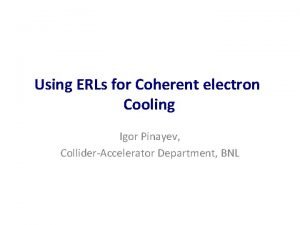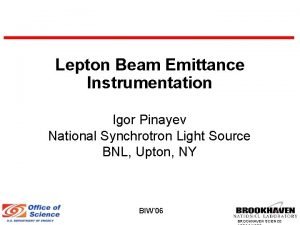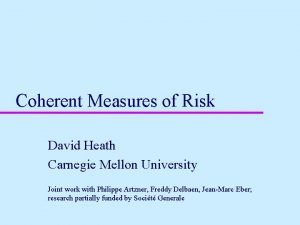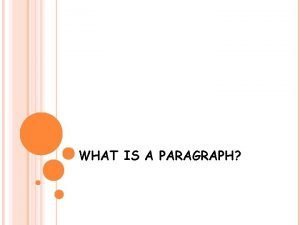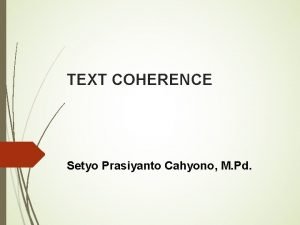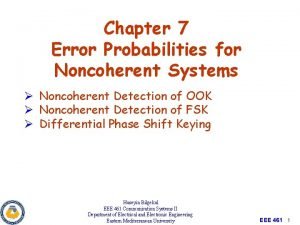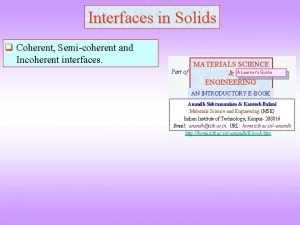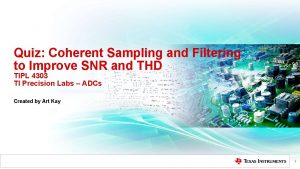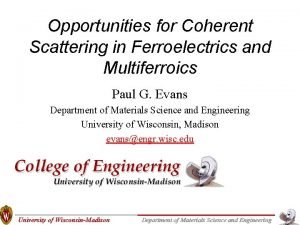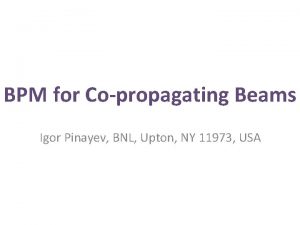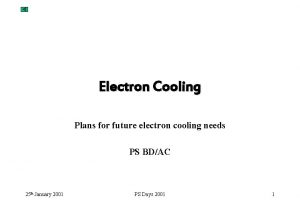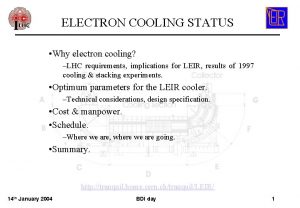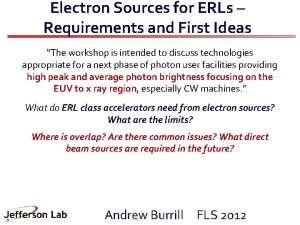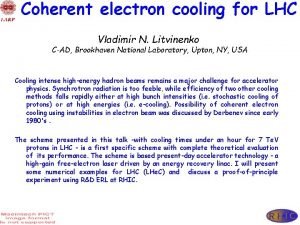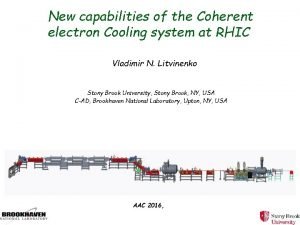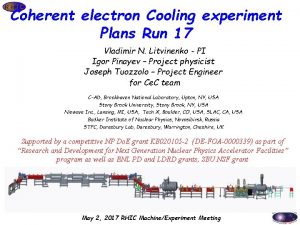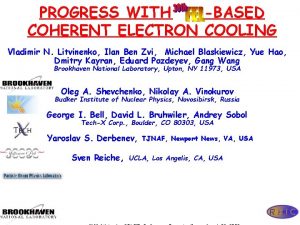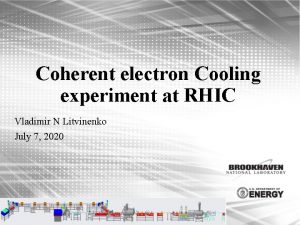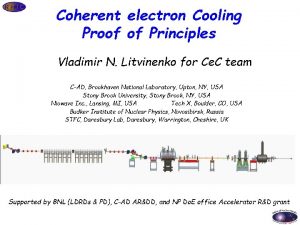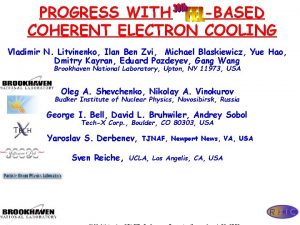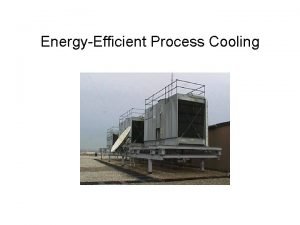Using ERLs for Coherent electron Cooling Igor Pinayev














- Slides: 14

Using ERLs for Coherent electron Cooling Igor Pinayev, Collider-Accelerator Department, BNL

Motivation • Traditional stochastic cooling does not have sufficient bandwidth to cool intense proton beams (~3× 1011 p/nsec) and can not provide two orders of density increase for heavy ion beams • Efficiency of traditional electron cooling falls as as high power of hadron’s energy • Synchrotron radiation is rather fable due to the heavy masses. For the same reason optical stochastic cooling is not suitable Species Energy, Ge. V/u Stochastic cooling, hrs Electron Cooling, hrs Ce. C, hrs 1 D/3 D Au 130 1 1 0. 015/0. 3 p 325 100 > 30 0. 3/1

Coherent Electron Cooling (Ce. C) At a half of plasma oscillation Dispersion E < Eh Hadrons Modulator l 1 Dispersion section ( for hadrons) Eh E > Eh High gain FEL (for electrons) Kicker l 2 Electrons 2 RD FEL vh Debay radii Amplifier of the e-beam modulation in an FEL with gain GFEL ~102 -103 FEL E 0 E > E 0 2 RD// FEL Density E < E 0 Ez

3 D FEL response calculated Genesis 1. 3, confirmed by RON The amplitude (blue line) and the phase (red line, in the units of ) of the FEL gain envelope after 7. 5 gain-lengths (300 period). Total slippage in the FEL is 300 , =0. 5 m. A clip shows the central part of the full gain function for the range of ={50 , 60 }.

e. RHIC Ce. C Layout ~ 100 m • Hadron beam line: – 2 dipoles, 2. 5” gap, 1. 6 T, 8 m each – 12 quadrupoles, 2. 5”, 20 T/m, 2. 5 m each – 20 dipole trims: 10 A, 20 V • Electron beam line – – 6 dipoles, 2. 5” gap, 0. 3 T, 0. 4 m each 16 quadrupoles, 2. 5”, 7 T/m, 0. 3 m each FEL: period 4 cm, length 12 m 30 dipole trims: 1 A, 10 V FEL Length 12 meters Kicker – 20 m Modulator – 20 m FEL wavelength 0. 56 -14 (50 -250 Ge. V) Delay in FEL 0. 185 -1. 1 mm

Possible ERL Configuration From Ce. C ~ 10 m To Ce. C ~ 50 m 30 Me. V 6. 7 Me. V 30 Me. V 112 MHz 336 MHz 112 MHz Beam dump SRF gun

ERL Beam Parameters Parameter Value Electron beam energy 25 -140 Me. V Electron beam current 50 m. A Bunch charge 5 n. C Repetition rate 9. 38 MHz Bunch length 0. 2 nsec Normalized emittance < 3 mm mrad Relative energy spread <10 -4

Ce. C Po. P experiment

Layout of Ce. C experiment in IP 2 IR Port Location of 3 PW Kicker Section Beam Dump Helical Wigglers Gun Modulator Section Accelerator Section Buncher Cavities

Injector Section SRF gun – 113 MHz, 2 MV design Two 500 MHz bunching cavities Drift space with diagnostics: ICT, BPMs, profile monitors, BPMs, slits for emittance measurement, Faraday cup

Photocathode

Accelerator Cavity • 704 MHz frequency • 20 MV accelerating voltage • Ready to be shipped next week

Helical Wigglers All three wiggler were delivered to BNL. We are waiting for magnetic measurement equipment to be shipped and perform measurements on site prior installation.

Summary • Coherent electron cooling is of critical importance for the e. RHIC • High requirements on the beam quality and high electron beam power dictate usage of energy recovery linac • Base parameters of the electron beam design are defined but the final design depends on the findings of the proof-of-principle experiment, which is progressing at RHIC
 Pinayev
Pinayev Pinayev
Pinayev David eber cmu
David eber cmu Coherent examples
Coherent examples Types of paragraph
Types of paragraph Coherent text
Coherent text Probability of error for non coherent fsk
Probability of error for non coherent fsk Coherent line drawing
Coherent line drawing Coherent interface
Coherent interface Domain 1: planning and preparation reflection examples
Domain 1: planning and preparation reflection examples Coherent sampling
Coherent sampling Coherent scattering
Coherent scattering Writing a coherent review of literature
Writing a coherent review of literature Example of cohesion
Example of cohesion May
May
